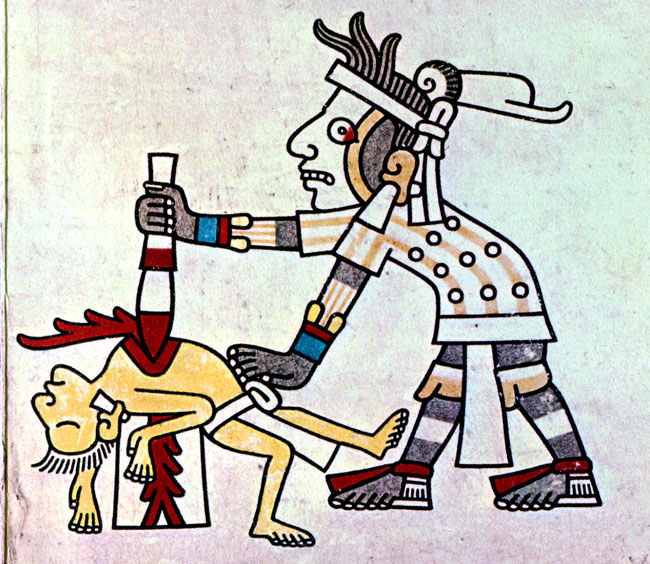CANDACE OWENS COMMENTS ON
NATIVE SACRIFICE (FACT CHECK)


Several days ago a video went viral of Candace Owens discussing the issue of violence and cannibalism in Native America and Mesoamerica (ancient Mexico). Along with Owens’ comments about the Aztecs killing hundreds of thousands of people by human sacrifice, she stated, “They were literal cannibals. It’s been proven without a shadow of doubt. The New York Times even ran a piece on it.” Indeed this caught the attention of millions of people including American media outlets that tried to discredit her claim. So the question we must answer is, Did human sacrifice and cannibalism take place in Native America and Mesoamerica? To answer this question, we will look at documents, existing research, and material culture left behind by Native people.
Violence and Cannibalism in Pueblo/Anasazi
When I studied the ancestral Pueblo people of the American Southwest at Arizona State University the topic of extreme cases of violence including cannibalism came up several times. Although this issue is quite sensitive, we can not overlook evidence found in the archaeological record. During the Great Drought (1270 – 1300 AD) crop failure, reorganization, and violence occurred across the Pueblo world. While some Pueblo groups in the Kayenta region migrated south into the Hohokam region, others stayed and accepted a new form of religious practice which became implemented in certain areas. As the Great Drought forced groups to become less sedentary evidence of rogue Puebloan groups raided villages, slaughtered and dismembered people in their houses, and resorted to cannibalism. Evidence of such practices includes pot polish on human bones, digested human DNA in fecal remains, scattered human remains indicating the displacement and uncared practice of proper burial practices, and cut marks on human bones which indicate butchering. At large cities such as Pueblo Bonito in Chaco Canyon, we do not see evidence of cannibalism; however, there are clear signs of elite status in burial contexts.
Sacrifice in Cahokia
Covering over 2,000 acres Cahokia is one of the largest prehistoric settlements in America. By far the most elaborate and sophisticated features are the platform mounds covering the area. With more than 50 million cubic feet of earth, it’s hard not to become amazed at how much work was put into these structures. At the center of Cahokia sits Monk’s Mound comprising of 22 million cubic feet of earth and measures about 1,000 feet long, 800 feet wide. Although Cahokia is impressive, there are cases of violence and human sacrifice. In mound 72 we find a mass grave holding 270 burials primarily consisting of young female captives that were sacrificed. Each victim did not show signs of trauma, thus suggesting strangulation or blood letting. In the same mound, 39 men and women who range from 15 to 45 in age were subjected to physical violence including brutal fractures, decapitation, and arrow wounds.
https://www.pbs.org/video/mound-72-9qcdnk/
Sacrifice in Mesoamerica
Before Spanish contact Mesoamerica was one of the largest populated areas on the planet. Cultures such as the Zapotec, Toltec, Mixtec, Maya, Teotihuacanos, and Aztecs created incredible city states that rivaled what was created in Rome. Public and private architecture was monumental and religious practices were displayed heavily through exquisite material culture specimens. Furthermore, agriculture in Mesoamerica fed millions of Native people and hierarchy consumed nearly every civilization throughout the region. Many traditions, practices, and trade items in Mesoamerica were not unnoticed in other regions of the world. Influences in iconography, architecture, and material technologies were carried well into the American Southwest where they slowly spread out into much of the eastern United States. Indeed, Mesoamerica was an incredible place! However, violence in religion and daily living practices became elevated as time continued to travel forward.
Teotihuacan
Through archaeological investigations we discovered 218 sacrificial victims buried in a long pit just south of the pyramid of Quetzalcoatl. The victims were predominantly male dressed in military attire which could suggest they were captives or prisoners from a neighboring village. In 2004 further work in data recovery revealed sacrifices at the pyramid of the moon. These sacrifices were comprised of 12 individuals with their hands tied behind their back, 10 of whom were decapitated and tossed into a burial vault within the pyramid. The other 2 sacrifices were richly ornamented with obsidian, figurines, shell, and other stone objects. Other sacrifices included wolves, coyotes, jaguars, and eagles. Some evidence suggests jaguars were released upon sacrificial victims prior to dismemberment.
Maya
In the Mayan world sacrifice and blood letting is nothing undiscovered–in fact artistic and detailed murals display clear evidence of such practices. As environmental conditions became harsher and farming became increasingly complex due to nutrient depletion, the Maya gave more blood to the gods in hope that crops would supply an increasingly hungry people. The fingernails of captives were ripped out from the body, soft parts of the skin such as ears and scrotums were pierced and cut, obsidian laced ropes were pulled through the mouths of priests, and blood was baked into corn cakes before it was served. The city of Chichen Itza (a main focus of Maya regional power in the Late Classic Period) appears to have been a major focus of human sacrifice. Captives were tied up and thrown into cenotes where they were left to drown. To this day we find thousands of human remains in Mayan cenotes. In addition, at some Mayan cities the chest cavities of captives were pierced with an obsidian blade and the victim’s heart was ripped out from the body where it was then presented to a temple idol. Finally, like much of the Mesoamerican region the ball game served an important element to the Maya. A stone and earthen court has hoops along the wall where a ball was struck from the payer’s hip and through the loop. Sounds innocent enough right? One key factor to this game is that the losing team would select a member or members to become sacrificed by means of decapitation. Later a stone skull was carved into the wall which represented the victim.
The Aztecs
In Aztec some of the most brutal human sacrifices took place. When Spanish conquistador Hernán Cortés and his army arrived in the Aztec capital of Tenochtitlán around 1521, they described witnessing a blood thirsty ceremony. A group of Aztec priests raised up a long obsidian knife and sliced open the chests of several sacrificial victims. They then offered the still-beating hearts to the gods as they tossed the victims’ lifeless body down the steps of the Templo Mayor. Andrés de Tapia, a conquistador, described as seeing “two rounded towers flanking the Templo Mayor made entirely of human skulls, and between them, a towering wooden rack displaying thousands more skulls with bored holes on either side to allow the skulls to slide onto the wooden poles.” These sacrificed victims were likely captives from the growing expansion of the Aztec empire. In addition to slicing out the hearts of victims and displaying thousands of skulls on racks, it’s believed that the Aztecs also practiced a form of ritual cannibalism. Sixteenth century illustrations show body parts being cooked in pots and archeology has identified shallow and deep butcher marks on the bones of human remains in Aztec sites scattered around Mesoamerica.

Conclusion
I am not a political commentator or journalist. I am an Anthropologist who has studied past and present cultures around the world. When Candace Owens made her comments many instantly discredited her and quickly made it a race issue. Admittedly I don’t agree with everything Owens says or presents in her video that is circulating on the web. For example, archaeological evidence does not point to “hundreds of thousands” of Aztec sacrifices. Rather, our data models collected through excavation and site analysis points to about 84,400 men, women, and children being sacrificed. Also, the notion that sacrifice stopped when the white man came to America is false. In Owens’ defense she is correct in her statement that many in the media and popular culture try to paint a beautiful picture composed of all Native people living in peace and harmony with the earth throughout prehistory and history. In reality that picture true to an extent. The media personalities whom criticized Owens failed to look at the clear and undeniable evidence we have recovered in data collections. Indeed, times of drought created social disturbances that lead to extreme violence and warfare which ultimately consumed many tribes throughout the world. Sacrifice on the other hand is not unique to America and Mesoamerica. Evidence clearly shows cultures around the planet conducted such practices with similar belief systems.
Author,
Jeff Martin






